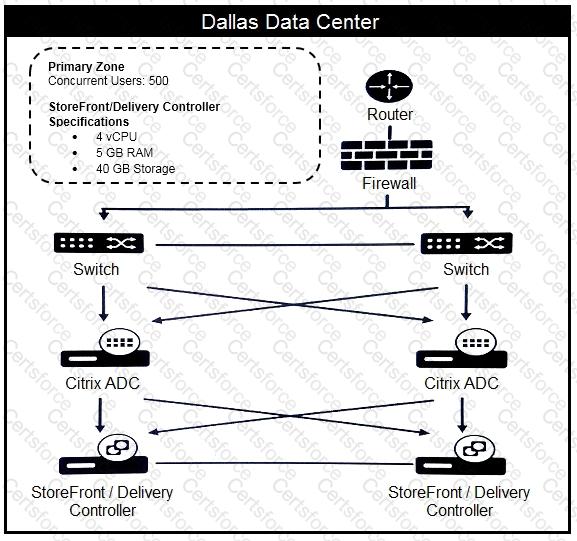Scenario: A Citrix Architect is designing a new Citrix Virtual Apps and Desktops environment. Currently, the environment is configured with 2 locations with identical Citrix Virtual Desktops Sites. Each Site has 2 Delivery Controllers, 2 StoreFront servers, and 1 Citrix ADC high-availability pair. The same applications have been published from both Sites for all users. Two zones (Zone A and Zone B) are configured in each Site with 1 Delivery Controller in each zone. The Microsoft Exchange server is only accessible from Virtual Delivery Agent (VDA) machines in Zone A in each Site.
Six access requirements have been identified:
Users should have a single URL when accessing resources from different Sites.
Users should always connect to the data center closest to their location.
Applications added to Favorites within the Citrix Workspace app should be retained when accessed from different Sites.
Launched applications and desktops should always connect through a local Citrix ADC.
No duplication of applications published from different Sites.
Microsoft Outlook should always launch in Zone A.
What should the architect recommend to ensure that Microsoft Outlook always launches from Zone A for every user?
Scenario: A Citrix Architect designed an active-passive Citrix Virtual Apps and Desktops environment, where the passive data center serves as the disaster recovery (DR) data center for all users.
Twelve items have been configured:
Citrix ADC Global Server Load Balancing (GSLB) to provide single URL direction to the active data center.
GSLB has health monitors configured for the load balanced servers.
Citrix Gateways are on both data centers.
Citrix ADC load balancing occurs for StoreFront and Delivery Controller XML services.
A single Citrix Virtual Apps and Desktops Site exists.
Four Delivery Controllers are members of the Site.
Two Delivery Controllers are members of the Primary Zone in the active data center.
Two Delivery Controllers are members of the Satellite Zone in the passive data center.
SQL is deployed in the active data center.
Local Host Cache is enabled.
Two StoreFront servers are deployed in each data center aggregating resources from the Delivery Controllers in the respective data center.
Virtual Delivery Agent (VDA) machines are deployed in both data centers and configured to register with Delivery Controllers in their zone.
What would happen if the Delivery Controllers in the primary data center were turned off?
Scenario: A Citrix Architect is assessing an existing infrastructure for a company that has storage challenges as a result of hyper-growth. They currently have a large IT infrastructure that consists of 15 hypervisor hosts and more than 200 virtual machines (VMs) worldwide. Management has advised the architect that they need to improve their storage infrastructure to include high performance and scalability.
Which storage solution should the architect implement within this infrastructure?
Scenario: A Citrix Architect is designing a new Citrix Virtual Apps and Desktops environment. While performing a capabilities assessment of the existing infrastructure, it was discovered that there are issues with load balancing users, and that the existing load-balancing hardware is outdated.
Which capability risk will the architect need to investigate to address these issues?
Scenario: An automobile manufacturer in Germany has deployed a Citrix Virtual Apps and Desktops solution for its employees using Citrix Cloud and uses a resource location in Germany. Recently, they acquired an automobile manufacturer in Japan. Since then, users from Japan have reported issues regarding slowness and degraded performance of the application hosted in the German resource location.
How can a Citrix Architect improve the performance of the application for users in Japan?
Scenario: An IT department moved its entire infrastructure to Microsoft Azure. It is utilizing multiple Azure regions for redundancy. It also uses all Azure regions as resource locations within Citrix Virtual Apps and Desktops Service in Citrix Cloud.
Which storage replication option will allow data to be read from both the primary and secondary locations?
Scenario: A Citrix Architect is using LDAP as single-factor authentication (SFA). The architect is migrating the environment to Citrix Cloud and wants to retain the same authentication, procedure for Citrix Virtual Apps and Desktops service in Citrix Cloud.
Which deployment strategy should the architect use for the Access Layer to ensure that the solution reduces management and does NOT incur additional costs?
Scenario: A Citrix Architect is designing a single-Site Citrix Virtual Apps and Desktops production environment. Through earlier design discussions, the architect has determined the environment details listed in the exhibit
Click the Exhibit button to view the details.

What should the architect change in the current environment to align with Citrix leading practices?
Scenario: A Citrix Architect designing a new Citrix Virtual Apps and Desktops environment needs to determine which endpoints to include. Based on discussions with various departments, the user requirements listed in the exhibit were collected.
Click the Exhibit button to view the requirements.

In addition to the user requirements, the architect must address the organizational requirement of minimizing endpoint management effort.
Which endpoint type should the architect use for the Sales Group, based on the requirements?